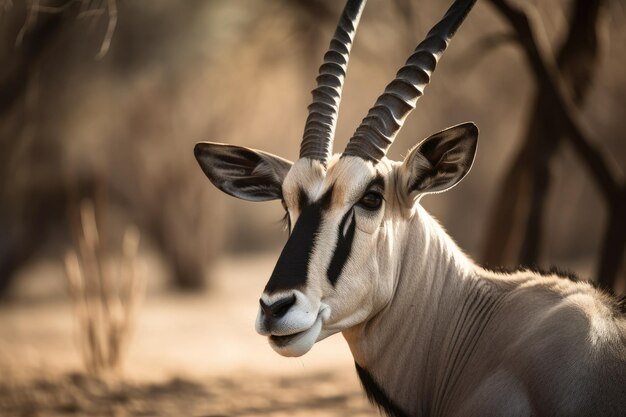
Understanding the oryx has a lot to do with separating fact from fiction. You might be wondering, “Are they really as tough as they look? Can they survive in extreme conditions?” Let’s dive into some of the most common myths about oryxes and uncover the truths behind them.
Myth 1: Oryxes Are Just Like Regular Antelopes
When you first see an oryx, it’s easy to lump them in with other antelope species due to their similar body shapes. However, here’s the thing: oryxes belong to a different genus called *Oryx*. While they share some traits with regular antelopes, they have unique adaptations that set them apart.
Oryxes are built to thrive in extremely arid environments. Their bodies are designed to conserve water, which is crucial when living in environments like the deserts of Africa. Unlike many other antelopes, oryxes can tolerate higher levels of dehydration. They can even raise their body temperature to reduce water loss, which is pretty impressive! So, while they may look similar at first glance, oryxes possess incredible adaptations to their specific habitats.
Myth 2: Oryxes Are Always Found in Desert Conditions
Many people assume that oryxes are strictly desert dwellers. Sure, they are famously adapted to arid climates, but they can also be found in various other environments! Oryxes inhabit open savannas and grasslands as well, where food and water are available.
Their adaptability shines through in how they manage to find water. In the wild, oryxes can survive on moisture from their food, like succulent grasses and leaves. They’re not solely dependent on standing water sources, which allows them to venture into diverse habitats. So, don’t limit your understanding of oryxes to the harsh deserts—they have a wider range than you might think!
Myth 3: Oryx Horns Are Just For Show
If you’ve ever seen an oryx, you’ll easily be captivated by their impressive horns. But here’s where the myth kicks in: some people believe these horns are purely decorative. In reality, they serve several important purposes—mostly related to survival.
Oryx horns can reach lengths of about 3 feet! Both males and females sport these impressive horns, which they use for defense against predators. When threatened, oryxes can skillfully utilize their horns to fend off attackers. Plus, they also participate in sparring matches among themselves, which helps establish dominance during mating seasons. So, those beautiful horns are far from just a pretty accessory; they play a vital role in their lives!
Myth 4: Oryxes Are Aggressive Creatures
Many folks picture wild animals like oryxes as fierce and aggressive, ready to charge at any moment. While oryxes can certainly defend themselves when necessary, they’re generally more on the shy side. They’re not keen on confrontation and tend to avoid fights whenever possible.
In fact, oryxes are social animals and often live in herds. These groups can help protect each other from predators. When feeling threatened, they may choose to flee rather than fight. This makes them more skittish than aggressive, which can be a significant misconception among those unfamiliar with their behavior.
Myth 5: Oryxes Are Endangered Everywhere
It’s easy to assume that because oryxes inhabit harsh environments, they must be endangered. While some oryx species, like the Arabian oryx, faced serious threats and were indeed on the brink of extinction, many populations are now rebounding. Conservation efforts have made a significant difference.
The Arabian oryx has made a remarkable recovery thanks to breeding programs and reintroduction efforts. However, it is essential to note that not all oryx species face the same level of threat. Other species, like the gemsbok, are more stable and can thrive in their environment. So, while some oryx populations need ongoing conservation, it’s not accurate to say they are endangered everywhere.
Myth 6: Oryxes Only Feed on Grass
It’s easy to think that because oryxes live in grassland areas, grass is their primary source of food. While they do enjoy grazing on grass, their diet is more varied than you might expect. Oryxes are browsers too!
They will munch on leaves, fruits, and even the bark of certain trees. Their ability to adapt their diet based on what’s available showcases their resilience. In harsher conditions, they can rely on tougher plants that other animals might not be able to eat. This adaptability helps ensure they can thrive, even when food options are limited.
Myth 7: Oryxes Are Solo Animals
You might envision an oryx as a solitary creature, wandering alone across the plains. While oryxes can be seen foraging by themselves, they actually prefer to stay in groups. Living in herds not only provides protection from predators but also facilitates social interactions among the animals.
These herds can range in size, sometimes with just a few individuals or even up to 40 members! The bonds formed within these groups can help them find food and water sources. Herding behavior enhances their chances of survival and showcases their social nature better than the lone-wolf image.
Understanding the myths and misconceptions about oryxes allows us to appreciate these remarkable animals on a deeper level. They’re not simply “just another antelope” but a unique species with fascinating adaptations. From their incredible ability to survive in harsh conditions to their social behaviors, oryxes are truly special creatures.
So, the next time you hear someone talk about oryxes, you might find yourself setting the record straight. You’re now equipped with reliable information, ready to educate others about these magnificent animals. Celebrate their survival, and remember that each species has a story worth telling!

